We’re back with another episode of DBO with Keith Perhac. This week, Keith chats with Anansi’s Say Gabriel. Say’s main goal in life is to create cohesive systems that support strong communities.
Frustrated by watching stressed-out digital leaders get mired in constantly shoring up shoddy systems, Say set her focus to the digital world a decade ago, just as it was rising in impact on everyday life. Today, Say helps agency leaders troubleshoot and build strong marketing, operations, and admin systems.
In this interview, Keith and Say discuss:
- The importance of modifying your typical checklist SOP
- The differences and the benefits of both a top-down system and a bottom-up system
- How she reduced her team’s revision process from 2-3 week to just 45 minutes
Say’s motto for her team is, “Done is the new perfect.” She believes failure is just the first step to success and she wants to get you just as excited as she is about effective processes and how they can not only help you, but they can help your team, your clients, your marketing, your sales, and so much more.
Find Say at:




